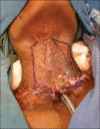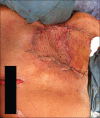Management of radiation wounds
- PMID: 23162232
- PMCID: PMC3495383
- DOI: 10.4103/0970-0358.101311
Management of radiation wounds
Abstract
Radiotherapy forms an integral part in cancer treatment today. It is used alone or in combination with surgery and chemotherapy. Although radiotherapy is useful to effect tumour death, it also exerts a deleterious effect on surrounding normal tissues. These effects are either acute or can manifest months or years after the treatment. The chronic wounds are a result of impaired wound healing. This impairment results in fibrosis, nonhealing ulcers, lymphoedema and radionecrosis amongst others. This article will discuss the pathophysiology in brief, along with the manifestations of radiation-induced injury and the treatment available currently.
Keywords: Lymphoedema; osteoradionecrosis; plexopathy; radiotherapy; wounds.
Conflict of interest statement
Figures






Similar articles
-
Modern Dressings in Prevention and Therapy of Acute and Chronic Radiation Dermatitis-A Literature Review.Pharmaceutics. 2022 Jun 6;14(6):1204. doi: 10.3390/pharmaceutics14061204. Pharmaceutics. 2022. PMID: 35745777 Free PMC article. Review.
-
MMP-8 is the predominant collagenase in healing wounds and nonhealing ulcers.J Surg Res. 1999 Feb;81(2):189-95. doi: 10.1006/jsre.1998.5495. J Surg Res. 1999. PMID: 9927539
-
Radiation-Induced Skin Ulcer.2023 Aug 8. In: StatPearls [Internet]. Treasure Island (FL): StatPearls Publishing; 2025 Jan–. 2023 Aug 8. In: StatPearls [Internet]. Treasure Island (FL): StatPearls Publishing; 2025 Jan–. PMID: 29939541 Free Books & Documents.
-
A Single-center, Retrospective Study of Cryopreserved Umbilical Cord for Wound Healing in Patients Suffering From Chronic Wounds of the Foot and Ankle.Wounds. 2016 Jul;28(7):217-25. Wounds. 2016. PMID: 27428716
-
Radiation injury.Surg Oncol Clin N Am. 1996 Oct;5(4):809-24. Surg Oncol Clin N Am. 1996. PMID: 8899946 Review.
Cited by
-
Pioneering technique using Acellular Dermal Matrix in the rescue of a radiation ulcer.G Chir. 2016 Jan-Feb;37(1):46-8. doi: 10.11138/gchir/2016.37.1.046. G Chir. 2016. PMID: 27142826 Free PMC article.
-
A novel surgical method of managing a high output pharyngostome.Ann R Coll Surg Engl. 2014 Nov;96(8):e1-2. doi: 10.1308/003588414X13946184902361. Ann R Coll Surg Engl. 2014. PMID: 25350164 Free PMC article.
-
Management of Radiation-induced Tissue Injuries: A Review of Current Treatment Strategies.Plast Reconstr Surg Glob Open. 2023 Jun 16;11(6):e5043. doi: 10.1097/GOX.0000000000005043. eCollection 2023 Jun. Plast Reconstr Surg Glob Open. 2023. PMID: 37456134 Free PMC article.
-
Does Preoperative Radio(chemo)therapy Increase Anastomotic Leakage in Rectal Cancer Surgery? A Meta-Analysis of Randomized Controlled Trials.Gastroenterol Res Pract. 2014;2014:910956. doi: 10.1155/2014/910956. Epub 2014 Nov 12. Gastroenterol Res Pract. 2014. PMID: 25477955 Free PMC article. Review.
-
Prophylactic transanal decompression tube versus non-prophylactic transanal decompression tube for anastomotic leakage prevention in low anterior resection for rectal cancer: a meta-analysis.Surg Endosc. 2017 Apr;31(4):1513-1523. doi: 10.1007/s00464-016-5193-2. Epub 2016 Sep 12. Surg Endosc. 2017. PMID: 27620910
References
-
- Gieringer M, Gosepath J, Naim R. Radiotherapy and wound healing: Principles, management and prospects. Oncol Rep. 2011;26:299–307. - PubMed
-
- O’Sullivan B, Rumble RB, Warde P Members of the IMRT Indications Expert Panel. Intensity-modulated Radiotherapy in the Treatment of Head and Neck Cancer. Clin Oncol (R Coll Radiol) 2012;24:474–87. - PubMed
-
- Sciubba JJ, Goldenberg D. Oral complications of radiotherapy. Lancet Oncol. 2006;7:175–83. Review. - PubMed
-
- Basu T, Laskar SG, Gupta T, Budrukkar A, Murthy V, Agarwal JP. Toxicity with radiotherapy for oral cancers and its management: A practical approach. J Cancer Res Ther. 2012;8(Suppl 1):S72–84. - PubMed
LinkOut - more resources
Full Text Sources
Other Literature Sources

